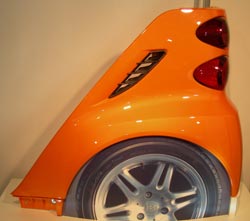Getting cars onto the road faster

The fender with integrated LED tail light developed in the Pegasus project has been produced for demonstration purposes. (© Fraunhofer ICT)<br>
The auto industry faces major challenges. New models are entering the market at ever shorter intervals, products are becoming more complex, and the trend towards electric cars requires modified vehicle structures. European production sites are coming under increasing cost pressure from low-wage countries.
Cost reductions, shorter production times, new materials and innovative assembly techniques are needed if companies are to remain competitive. To achieve these goals, 23 business and research organizations are participating in the EU’s Pegasus project (www.pegasus-eu.net). One of the research partners is the Fraunhofer Institute for Chemical Technology ICT in Pfinztal, which is contributing its expertise in the polymer engineering sector. The project partners have jointly developed a software platform to reduce development times and costs.
The Integrated Design and Engineering Environment (IDEE) is a CAD/CAE/CAM software system which is connected to an intelligent database. It analyzes the functional requirements of a product and identifies appropriate materials at an early stage of the development process. If, for example, a car roof is to be made in a different material than before, it is not necessary to conduct a new development process. Instead, the design engineers enter the component data into the software system, which assesses the information and then selects suitable materials and manufacturing processes. The platform also provides engineering guidelines for designing the tools that will be used to produce the component. The project partners have demonstrated how this platform could work on the example of a fender with integrated LED tail light. “We used the original fender from a Smart. Our project demonstrates how this complex component can be produced more quickly and cheaply with new processing techniques, materials, bonding agents and tools,” says Timo Huber, a scientist at Fraunhofer ICT. Instead of conventional lamps, the project partners fitted LED tail lights to the fender. This reduced the number of separate parts from eight to five, and the number of processing steps from twelve to five. Material and cost savings were also achieved by using conductor paths made of electrically conductive polymer. The conductive carbon nanotubes conduct the electricity from the connector to the LEDs and render metallic conductor structures superfluous.
A further example application: So that components such as the LED tail lights can be dismantled more quickly, they are bonded using a special adhesive. For this the research scientists at Fraunhofer ICT and their project partners developed a new microwave-active adhesive bonding system. When irradiated with microwaves the individual components lose their adhesion and can be easily taken apart. This means that parts can be efficiently recycled into different categories. “In addition, we dyed the fender using newly developed pigments based on special nanoparticles,” states Huber. These nanostructures can be worked in particularly evenly, to dye plastics such as polypropylene. This means fewer pigments are needed than usual. “We have also taken the importance of protecting the climate into account. Further developments in local fiber reinforcement of structural vehicle components will reduce weight and therefore emissions of CO2,” the scientist adds, and sums up: “All in all the IDEE system will shorten development times, cut the number of assembly steps and reduce the amount of material consumed.” IDEE is still under development, but it can already be used to produce simple components. The software should be ready and available to the auto industry in about a year’s time.
Media Contact
All latest news from the category: Automotive Engineering
Automotive Engineering highlights issues related to automobile manufacturing – including vehicle parts and accessories – and the environmental impact and safety of automotive products, production facilities and manufacturing processes.
innovations-report offers stimulating reports and articles on a variety of topics ranging from automobile fuel cells, hybrid technologies, energy saving vehicles and carbon particle filters to engine and brake technologies, driving safety and assistance systems.
Newest articles

Trotting robots reveal emergence of animal gait transitions
A four-legged robot trained with machine learning by EPFL researchers has learned to avoid falls by spontaneously switching between walking, trotting, and pronking – a milestone for roboticists as well…

Innovation promises to prevent power pole-top fires
Engineers in Australia have found a new way to make power-pole insulators resistant to fire and electrical sparking, promising to prevent dangerous pole-top fires and reduce blackouts. Pole-top fires pose…

Possible alternative to antibiotics produced by bacteria
Antibacterial substance from staphylococci discovered with new mechanism of action against natural competitors. Many bacteria produce substances to gain an advantage over competitors in their highly competitive natural environment. Researchers…





















